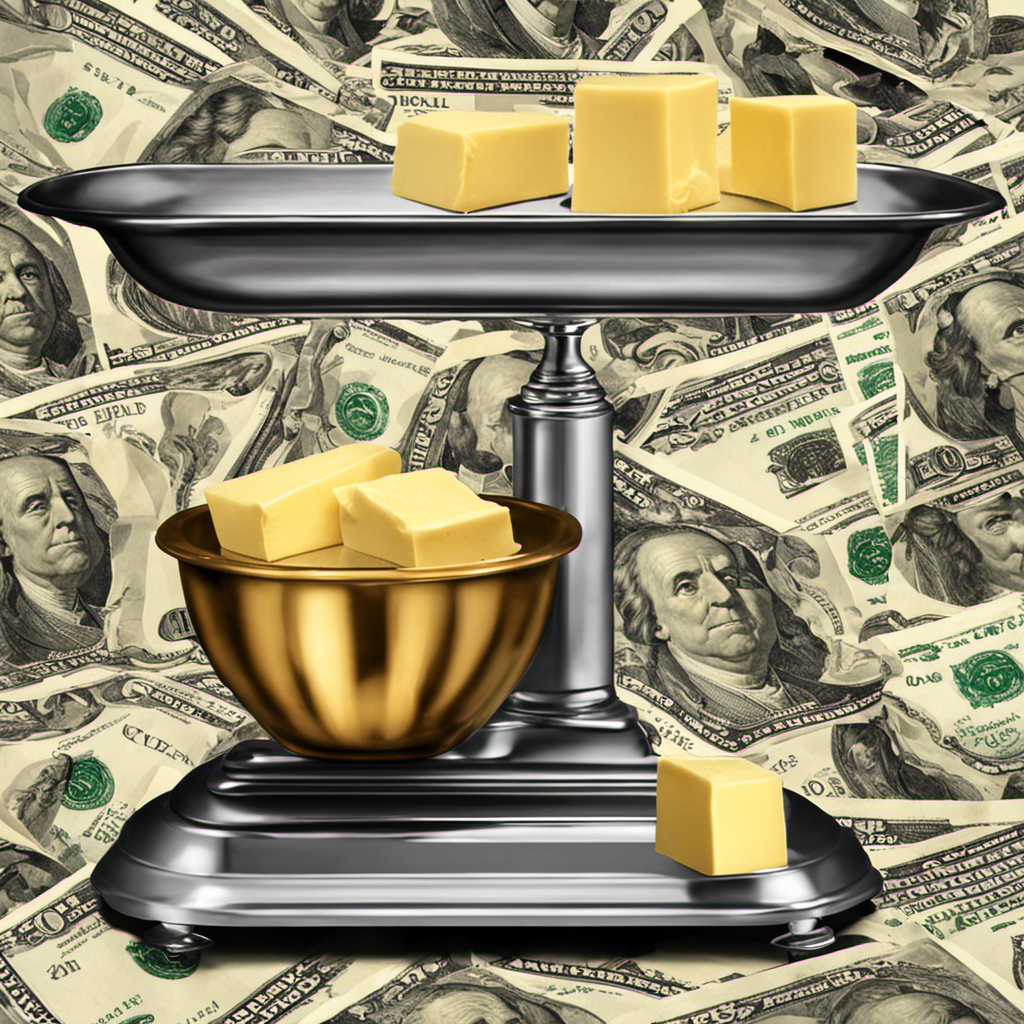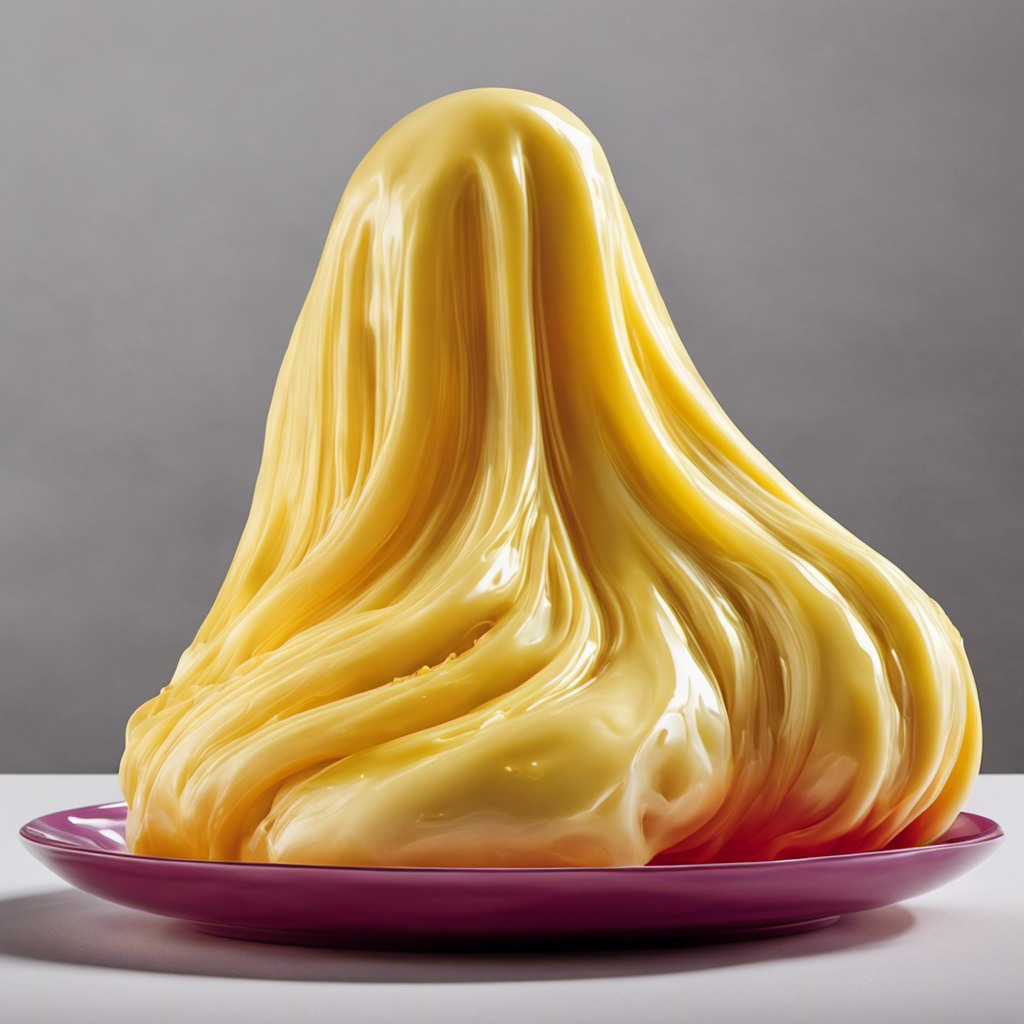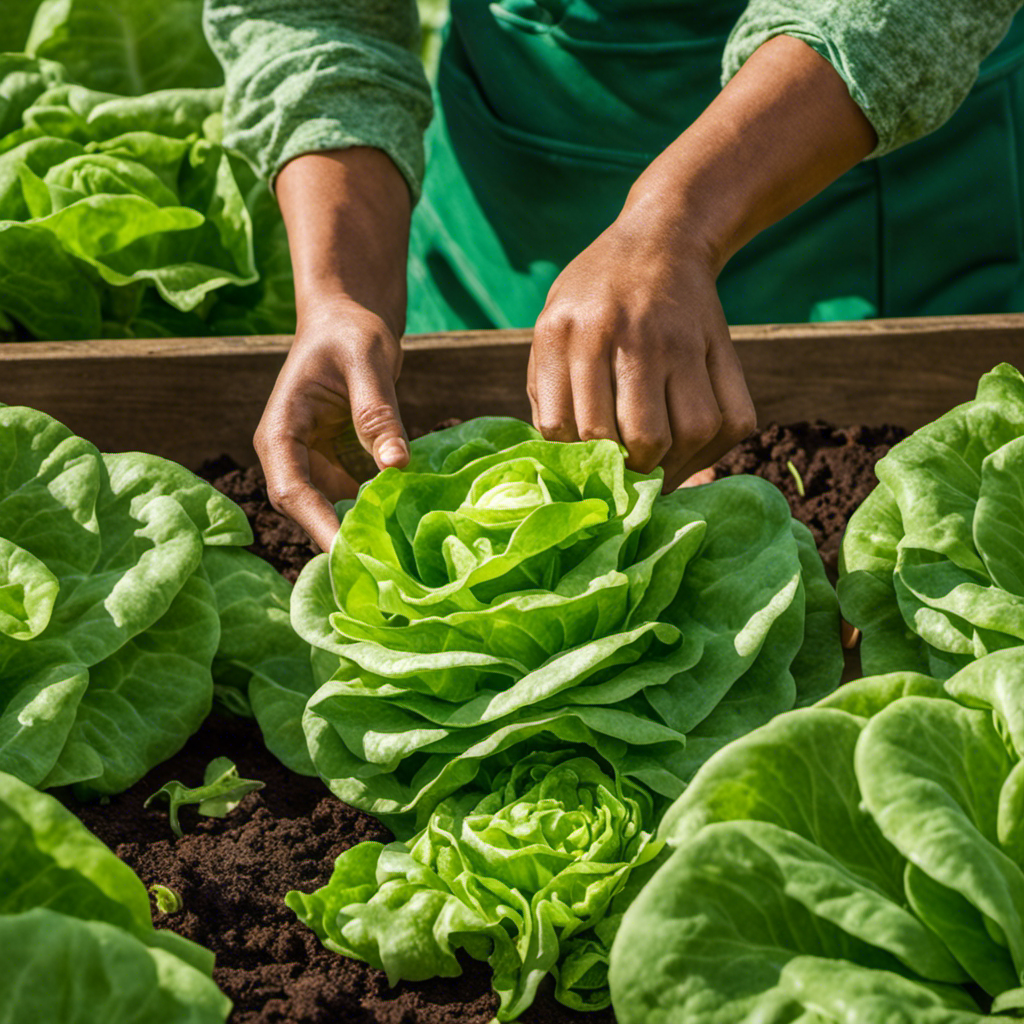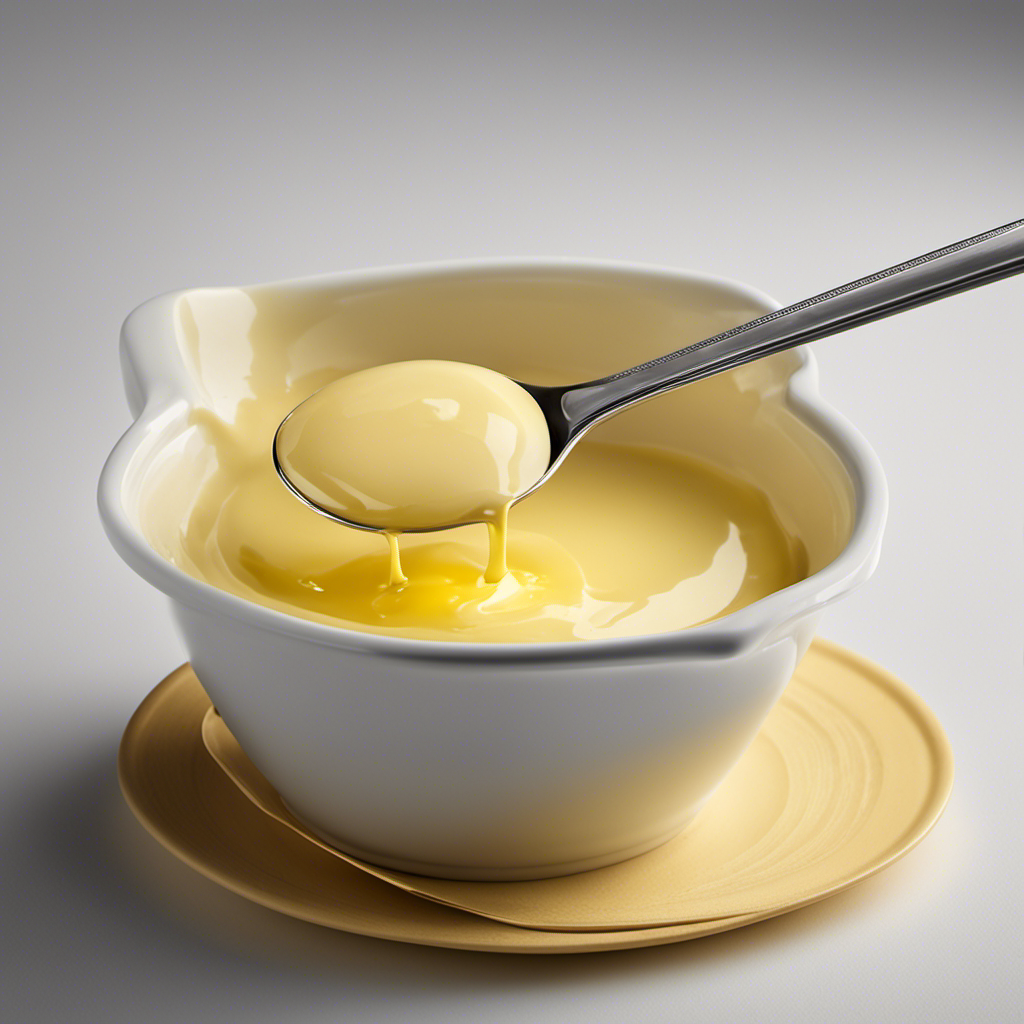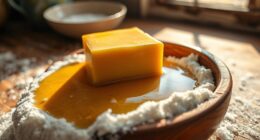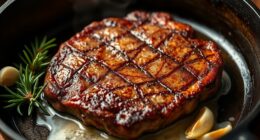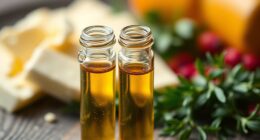Were you aware that the average price for a pound of butter differs depending on the location? Being a fan of butter, I found myself eager to discover the cost of enjoying this smooth indulgence.
In this article, I will explore the history of butter pricing, the factors that affect its prices, and regional variations in butter costs. Additionally, I will provide tips on how to find the best deals on butter and discuss alternative options and their associated costs.
So, let’s dive into the world of butter pricing and discover the true value of a pound of butter.
Key Takeaways
- Factors such as changes in agricultural practices, government regulations, and global supply and demand affect the cost of butter.
- Supply and demand can lead to price fluctuations in the butter market.
- Production costs, including labor and raw materials, impact the pricing of butter.
- Regional availability, cultural or culinary preferences, and transportation costs can contribute to variations in butter prices.
History of Butter Pricing
You might be wondering how the history of butter pricing affects the cost of a pound of butter today. Well, let’s dive into the fascinating history of butter production and consumption trends.
Butter has been a staple in human diets for centuries, with evidence of its production dating back to ancient times. In the early days, butter was primarily made from domesticated animals like cows and goats. As demand for butter grew, so did the methods of production.
The industrial revolution brought about advancements in butter production, making it more accessible and affordable for the masses. However, fluctuations in butter production and consumption trends over the years have influenced its pricing.
Factors such as changes in agricultural practices, government regulations, and global supply and demand have all played a role in determining the cost of a pound of butter today.
Factors Affecting Butter Prices
Factors such as supply and demand, production costs, and market competition can influence the price of butter.
-
Supply and demand: If there is a shortage in butter production, the price will increase due to limited availability. On the other hand, if there is an oversupply, the price may decrease as producers try to sell their excess stock.
-
Production costs: The cost of producing butter, including factors like labor, raw materials, and equipment, can impact its price. Fluctuations in these costs can lead to price changes in the market.
-
Market competition: The level of competition among butter producers can affect prices. When there are many producers, they may lower prices to attract customers. Conversely, if there are only a few producers, they may have more control over pricing.
With these factors in mind, it’s clear that the price of butter is influenced by several variables. Understanding these influences is important when analyzing the average cost of a pound of butter.
Average Cost of a Pound of Butter
When it comes to the average cost of a pound of butter, there are several factors that can lead to price fluctuations and trends. Understanding these factors is crucial in predicting and analyzing the cost of butter.
Additionally, it is important to compare the price of butter with other spreads in order to gain a comprehensive understanding of the market and make informed purchasing decisions.
Price Fluctuations and Trends
If you’re wondering about the cost of a pound of butter, it can vary due to price fluctuations and trends. Here is a price analysis of the impact of inflation on the cost of butter:
-
Inflation: Inflation is a key factor that affects the price of butter. When there is higher inflation, the cost of production, transportation, and packaging increases, leading to an increase in the overall price of butter.
-
Supply and Demand: The availability of butter in the market also plays a significant role in its price fluctuations. If there is a shortage in the supply of butter, the prices tend to rise. On the other hand, if the supply exceeds the demand, the prices may decrease.
-
Market Trends: Market trends, such as changes in consumer preferences or shifts in the dairy industry, can also impact the price of butter. For example, if there is a surge in demand for organic butter, the prices may increase.
Considering these factors, it is important to stay updated with market trends and be prepared for potential price fluctuations while purchasing butter.
Factors Affecting Cost
To better understand the cost of butter, you should consider how inflation, supply and demand, and market trends impact its price.
The history of butter production plays a significant role in its cost. Over the years, advancements in technology and farming practices have increased production efficiency, leading to lower costs.
However, the impact of climate on butter prices cannot be ignored. Extreme weather conditions, such as droughts or heatwaves, can affect the availability and quality of the milk used to make butter. This, in turn, can lead to a decrease in supply and an increase in prices.
Additionally, changes in consumer preferences, such as a growing demand for organic or grass-fed butter, can also influence the cost of butter.
Keeping these factors in mind is crucial for understanding the fluctuations in butter prices.
Comparisons With Other Spreads
Comparisons with other spreads can help determine which option is the most suitable for your taste and dietary preferences. When considering butter as a spread, it is often compared to margarine. Here are three key factors to consider when comparing butter and margarine:
-
Taste: Butter has a rich and creamy flavor that many people prefer. Margarine, on the other hand, often has a more artificial taste.
-
Health benefits: Butter is a natural product made from milk and contains essential nutrients like vitamins A, D, and E. It also provides a good source of healthy fats. Margarine, on the other hand, is usually made from vegetable oils and may contain trans fats and artificial additives.
-
Cooking properties: Butter is known for its excellent flavor when used in cooking and baking. Margarine may be a better option for those who need a dairy-free alternative or prefer a spread that can be used straight from the fridge.
Considering these factors, it is clear that butter offers distinct advantages in taste and nutrition. However, it’s important to consider individual dietary needs and preferences when making a choice between butter and margarine.
Transitioning to the next section about regional variations in butter prices, it’s worth noting that the cost of butter can vary depending on where you live.
Regional Variations in Butter Prices
There’s a lot of variation in butter prices depending on the region. Regional availability and consumer preferences play a significant role in determining the cost of butter.
Different regions have different levels of dairy production, which affects the supply and availability of butter. Some areas may have a higher demand for butter due to cultural or culinary preferences, leading to higher prices.
Additionally, transportation costs can also impact the final price of butter, especially in remote or rural areas. Consumer preferences for locally sourced or organic butter can also drive up prices in certain regions.
It’s important for consumers to consider these factors when purchasing butter and be aware that prices may vary depending on where they live.
Tips for Finding the Best Butter Deals
Finding the best deals on butter can be a money-saving strategy for savvy shoppers. Here are some tips to help you find discounts and compare brands:
-
Check store flyers and websites: Retailers often advertise special promotions and discounts on butter. Keep an eye out for weekly flyers or browse their websites for deals.
-
Use couponing apps: Many apps offer digital coupons and cash-back rewards for groceries, including butter. Look for apps like Ibotta or Checkout 51 to save even more on your purchase.
-
Follow social media accounts: Brands and retailers may post exclusive promotions or giveaways on their social media platforms. By following them, you can stay updated and take advantage of any special offers.
Butter Alternatives and Their Costs
When it comes to butter substitutes, there are several options available that are not only cheaper but also offer different nutritional values.
It’s important to consider these alternatives to butter, especially if you’re looking to save money or have specific dietary requirements.
In this discussion, we will explore the various cheaper butter substitutes and compare their nutritional values to help you make an informed decision.
Cheaper Butter Substitutes
Did you know you can find cheaper substitutes for butter? If you’re looking to save some money on your grocery bill, consider these alternatives:
-
Cheaper Margarine Options: Margarine is a popular butter substitute that is often less expensive. Look for store brand margarines or generic options, as they tend to be more affordable than name brands. Just make sure to check the ingredients and choose a margarine that doesn’t contain trans fats.
-
Homemade Butter Recipes: Making your own butter can be a cost-effective option. All you need is heavy cream and a mixer or blender. Simply whip the cream until it separates into butter and buttermilk. You can customize the flavor by adding salt, herbs, or spices. Plus, homemade butter has the added benefit of being free from preservatives and additives.
-
Oil-Based Spreads: Another alternative to consider is oil-based spreads. These spreads are made from vegetable oils and often come in a tub or squeeze bottle. They can be a more affordable option for spreading on toast or using in recipes that call for butter.
Nutritional Value Comparison?
After discussing cheaper butter substitutes, let’s now dive into the nutritional value comparison of various options.
When it comes to butter, it is essential to consider its health benefits and nutritional content. Butter is known for its high saturated fat content, which can increase the risk of heart disease when consumed excessively. However, butter also contains important nutrients like vitamins A, D, and E, as well as conjugated linoleic acid, which may have potential health benefits.
Comparing it to margarine, for instance, margarine is lower in saturated fat but may contain trans fats, which are associated with an increased risk of heart disease.
Other alternatives like coconut oil or olive oil offer different nutritional profiles, with coconut oil having higher saturated fat content and olive oil being a source of monounsaturated fats.
It’s important to consider your individual dietary needs and health goals when choosing between these options.
Frequently Asked Questions
How Does the Production Process of Butter Impact Its Price?
The production process of butter impacts its price through factors such as production cost, supply, and demand. Understanding these aspects can help determine the final price of a pound of butter.
Are There Any Regulations or Policies That Affect the Pricing of Butter?
Regulations and policies play a significant role in shaping the pricing of butter. From government subsidies to trade agreements, these factors impact the cost of production and ultimately determine the price we pay at the grocery store.
What Are Some Common Uses for Butter Besides Cooking and Baking?
In skincare, butter is commonly used as a moisturizer and to nourish dry skin. It is also believed to have healing properties and can be used as a natural remedy for minor cuts and burns.
Can the Quality of Butter Affect Its Price?
Yes, the quality of butter can definitely impact its price. Higher quality butter, such as organic or artisanal varieties, often costs more due to the use of premium ingredients and production methods. Pricing regulations also play a role in determining butter prices.
Are There Any Seasonal Fluctuations in Butter Prices?
Seasonal demand and market competition can lead to fluctuations in butter prices throughout the year. Factors such as holidays, baking seasons, and availability of milk can impact the supply and demand, causing prices to vary.
Conclusion
Well, who would’ve thought that a simple pound of butter could be so fascinating? After delving into the history, factors affecting pricing, regional variations, and even butter alternatives, it’s safe to say that the world of butter is a complex one.
But fear not, butter enthusiasts! Armed with this newfound knowledge, you’ll be able to navigate the butter market with ease, finding the best deals and maybe even discovering some unexpected alternatives along the way.
So go forth, butter lovers, and may your spreads be ever creamy and your wallets ever full!
